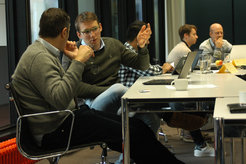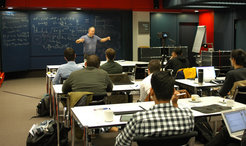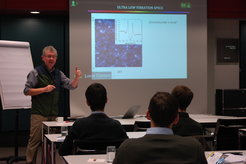MPGC-QM Kick-off week, 04.-08.11.2019
Strong Kick-off of the Max Planck Graduate Center for Quantum Materials
By pooling resources of several Max Planck Institutes across Germany and strong national and international partners, the newly founded Max Planck Graduate Center for Quantum Materials offers an innovative curriculum for graduate students and novel opportunities for research collaboration. The “Kickoff Week” of the Graduate Center at the MPI for Solid State Research in Stuttgart provided the first glimpse of this new approach.

The week began with a tutorial on scientific writing – arguably the most important “soft skill” of a beginning graduate student. Although publications serve as the most valuable “currency” in science, writing of a research publication is rarely taught in a systematic manner. To give students a head start in scientific writing, Principal Investigators Andrea Cavalleri (MPI Hamburg) and Bernhard Keimer (MI Stuttgart) teamed up with Paolo Radaelli (Oxford University) and English language tutor Hildegund Schaab. Following a survey of general guidelines for the composition of scientific manuscripts, the students wrote short scientific texts, which were then reviewed in one-on-one sessions with the senior scientists. In the closing discussion, the students rated these sessions as particularly helpful.
The kickoff week also marked the beginning of two courses on Frontiers of Research in Quantum Materials. The first course, From Molecular to Quantum Liquid Crystals, covers one of the most influential concepts in quantum materials research and its origins in classical condensed matter science. Liquid crystalline states in classical complex fluids have served both as prominent model systems for theories of topological defects and critical phenomena, and as a platform for modern display technologies. Frank Giesselmann (University of Stuttgart) and Holger Stark (Technical University of Berlin) summarized the large and beautiful literature in this field, focusing on the formation of topological defects in molecular liquid crystals, which precede current ideas in topological quantum materials research by many decades. Walter Metzner (MPI Stuttgart) gave an elementary introduction to the Fermi liquid theory (which is fundamental for quantum condensed matter, but rarely taught in graduate classes) and discussed the emergence of electronic nematic states via “Pomeranchuk instabilities”, with possible applications to cuprate superconductors. Joerg Schmalian (Karlsruhe Institute of Technology) surveyed current theories of electronic nematic states in iron pnictides and topological superconductors, as well as experimental strategies to detect such states via “strain tuning” of the electronic properties.

Roderich Moessner (MPI Dresden) gave a blackboard talk that began with an elementary treatment of Landau orbits of electrons in a magnetic field and ended with the theoretical description of “stripe” and “bubble” phases in quantum Hall systems. Finally Seamus Davis (a newly appointed Faculty Fellow of the Graduate Center at Oxford University and the University College Cork) described the technique of “spectroscopic imaging” in scanning tunneling microscopy as well as evidence of “electron nematic” motifs and “pair density waves” in spectroscopic images of high-temperature superconductors.
A second course on Big data and artificial intelligence in materials science is being organized by Matthias Scheffler (Fritz Haber Institute) and Claudia Draxl (Humboldt University Berlin). Machine-learning pioneer Bernhard Schoelkopf (MPI Tuebingen/Stuttgart) introduced machine-learning algorithms and current efforts to use these tools to identify causal relationships between empirical parameters across various fields of research. Luca Ghiringhelli (Fritz Haber Institute) described statistical-learning approaches to develop simple descriptors of materials properties from large databases. A particularly impressive example is his discovery of a simple combination of microscopic parameters that describes the stability of crystal structures – analogous to, but much more powerful than, the classical “tolerance factor”. In a talk that bridged both quantum liquid crystals and artificial intelligence, Seamus Davis finally reviewed a set of neural networks to identify motifs indicative of electronic nematic states in a large and growing database of spectroscopic images.

Following the successful “kickoff”, the Frontiers-of-Science courses will now continue remotely by video links between the institutes, until the next on-site meeting, which will take place in Berlin in the week of May 4. Based on students’ suggestion, this meeting will include a hands-on tutorial for machine-learning algorithms, in addition to a series of lectures to kick off the next video courses.


